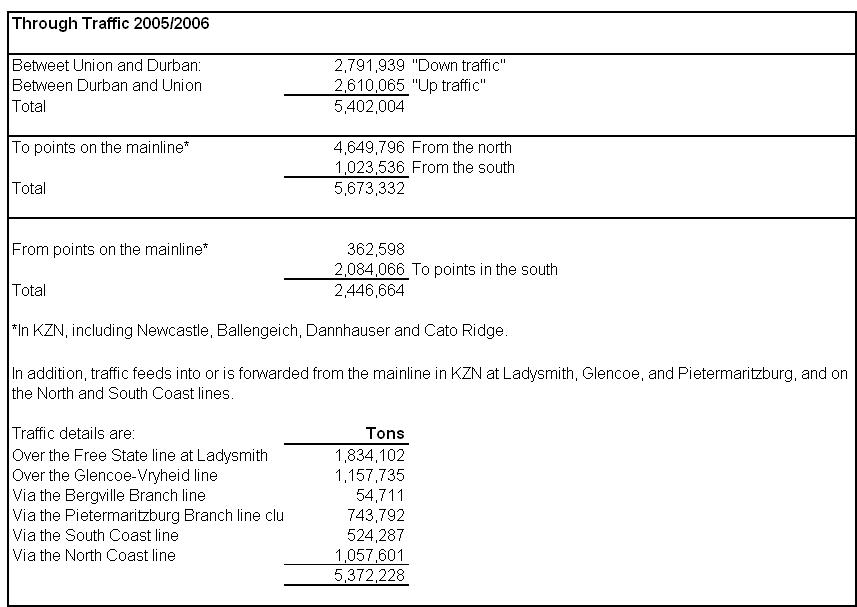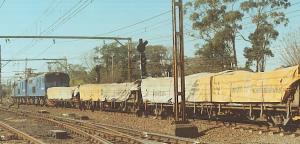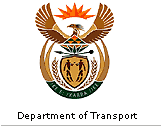 |
Durban-Ladysmith-Volksrust (and beyond to Union in Gauteng)

Southbound mineral train
|
This route is the main line between Durban and Gauteng,
and
is known as Natcor by the railway administration. It is
regarded as the most important general freight rail
route in South Africa, having carried over 20 million tons
of traffic on various portions of the route during the
railway administration’s 2005/2006 financial
year. Many
misleading claims have recently been made about traffic on
the route, suggesting about 9 million tons of rail freight
compared to over 30 million tons of road freight. It
appears that this refers only to end-to-end
traffic which, however, constitutes only part of the
traffic on this route.
For example, some traffic moves the full length of the
route between Union (in Gauteng) and Durban, while other
traffic originates in provinces to the north, east and
west, and runs to various destinations on the
mainline itself. Likewise, other traffic is forwarded from
various stations to points north and south. Finally, some
traffic moves between points to the north of Volksrust and
is, therefore, not recorded as KZN traffic. An example of
this is the large volume of coal which moves from the
Witbank area to the Majuba power station at Palmford.
Details of the traffic that was moved the full length of
the route in 2005/2006, is recorded below.

|
Traffic on these feeder routes is diverse. The Free State
line caters for export bulk chemical and containerised
traffic between Sasolburg, Durban and Richards Bay. Grain
traffic generated in the Free State is routed to various
points on the Natcor main line and for export. Four mills
in the Pietermaritzburg area received over 192,000 tons of
maize during 2005/2006 while one mill alone in Estcourt
received nearly 141,000 tons. Unfortunately, domestic
maize traffic has been shifting to road during the past 20
years. By contrast, some 230,000 tons of maize was
exported through Durban and over 500,000 tons of wheat was
imported and railed to various destinations, including
countries to the north.
Traffic over the Glencoe-Vryheid section comprised
import coking coal, export steel from Newcastle, and
other products originating in or being forwarded
from the west or north on the main line.
The Bergville branch generated pulpwood and
grain traffic. At Pietermaritzburg, the various branches
to the west and east generate over 650,000 tons of
pulpwood and wood chips destined mainly for the mills on
the North and South Coast. Bulk sugar and molasses
traffic was directed to Durban, Gauteng and other points
around South Africa.
Traffic from the South Coast routed over the main line
included bulk lime products to Gauteng, although most of
this traffic has been lost to road. Cement clinker from
the Simuma deposit near Port Shepstone was routed to the
plant at Mount Vernon, only about 5 km north of the
junction at Rossburgh, but nevertheless on the
mainline.
Both the North and South Coast lines received over 650,000
tons of pulpwood traffic from the Bergville and
Pietermaritzburg branches, while chemical traffic was
forwarded from the Umbogintwini industrial complex, 24 km
south of Durban. Finally, coal traffic was directed to
three locations on the South Coast line. In the case of
this traffic, the railway operator was unable to supply
all the needs of the various North and South Coast mills,
and increasing volumes of traffic, therefore, were being
conveyed by road.
Important industries located at Newcastle, Rooipunt,
Ballengeich, Estcourt, Pietermaritzburg, Cato Ridge and
Mount Vernon rely on rail transport, and receive large
volumes of input traffic for production and processing.
However, a smaller volume is dispatched by rail today as
road has captured
much of this finished-product traffic such as steel.
Containerised import and export traffic totalled 1,226,377
and 853,940 tons respectively during the review period.
This included traffic from Gauteng and provinces to the
east, west and north, as well as from countries to the
north of
the Limpopo.
It should be noted that north of Volksrust on the main
line, additional grain traffic was generated from the
Standerton (Firham)-Vrede branch and the Balfour
North-Bethlehem secondary lines. In addition, some 2,5
million
tons of coal was received from various Mpumalanga mines at
Palmford, site of a large power station. Road deliveries
of coal to this plant exceeded 10 million tons, and plans
are now in hand to construct a new ‘mini’
heavy-haul line
to the north near Bethal to tap the coal resources and
reduce dependence on road transport.
In summary, the total traffic over the full length of the
corridor or sections of it exceeded 20 million tons in
2005/2006. This included some 6 million tons of coal,
2,8 million tons of iron ore, 2 million tons of
containerised freight, over 1,4 million tons of iron and
steel products, 1,1 million tons of grains, and nearly
950,000 tons of liquid fuels, as well as some 45 other
commodities. Operations and InfrastructureThe Durban-Union (Gauteng) main line is of double
track
throughout, and is electrified at 3 kV DC. Train control
is by
CTC, operated from various stations along the line. The
ruling gradient in KZN is 1 in 50, although it eases to 1
in 80 between Volksrust and Union. There are currently
between 20 and 30 trains a day in each direction along the
route. This represents 20-25% of capacity.
Container trains are scheduled to run from Kings Rest in
Durban to Kaserne in Gauteng in 14 hours although delays
en-route can extend this to 19-20 hours.
Permissible
wagon axle loads are 20 tons, the main line standard. The
track infrastructure is generally good, although deferred
maintenance during the last 10-15 years has
lowered the
track quality index, particularly on the Cato Ridge to
Durban section which is subjected to higher rainfall. Line
formation quality is a concern in places, and this matter
is being investigated.
There are a number of large yards along the route. Of note
is the yard at Newcastle for the steel mill, as well as
another for Rooipunt traffic. Danskraal yard at Ladysmith
serves main line and Free State traffic, and is an
important crew change point. There is, in addition, an
electric loco running shed and wagon repair facility.
There are two yards in Pietermaritzburg, namely, Masons
Mill on
the mainline and Victoria on the Greytown branch line but
within the Pietermaritzburg municipal area. It is used
mainly to serve the nearby industrial area, while Masons
Mill is used to marshal timber trains destined for the
coastal mills. There is also another yard at Cato Ridge,
serving mainly the nearby ferro-manganese plant. There are
a number of yards in the Durban area, serving not only the
main line but the North and South Coast lines. Bayhead is
the main yard for general traffic, while Kings Rest serves
the container terminal. There are numerous industrial
lines serving port areas, and lines to the petroleum
sites.
At the Bluff, a coal terminal serves specialised coal
exports, and during 2005/2006 some 1,6 million tons
were received of which over 1,4 million tons came via the
main
line, the balance being from the coal line.

Cato Ridge Andalucite
|
For Details of
Volumes and Commodities Received
and Forwarded [Table 1]CLICK HERE
|
 |



